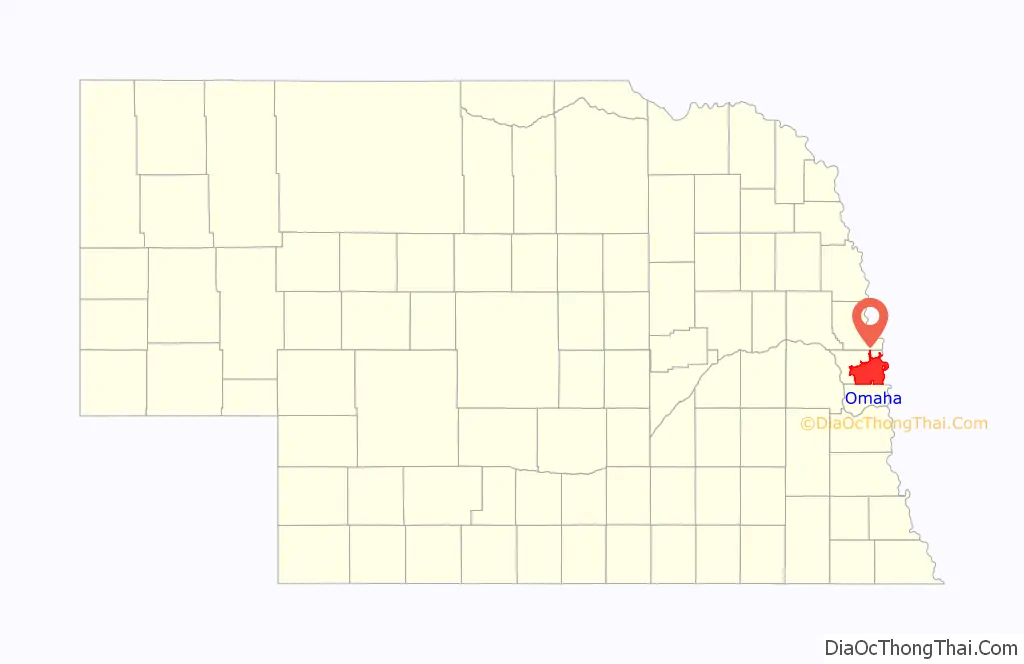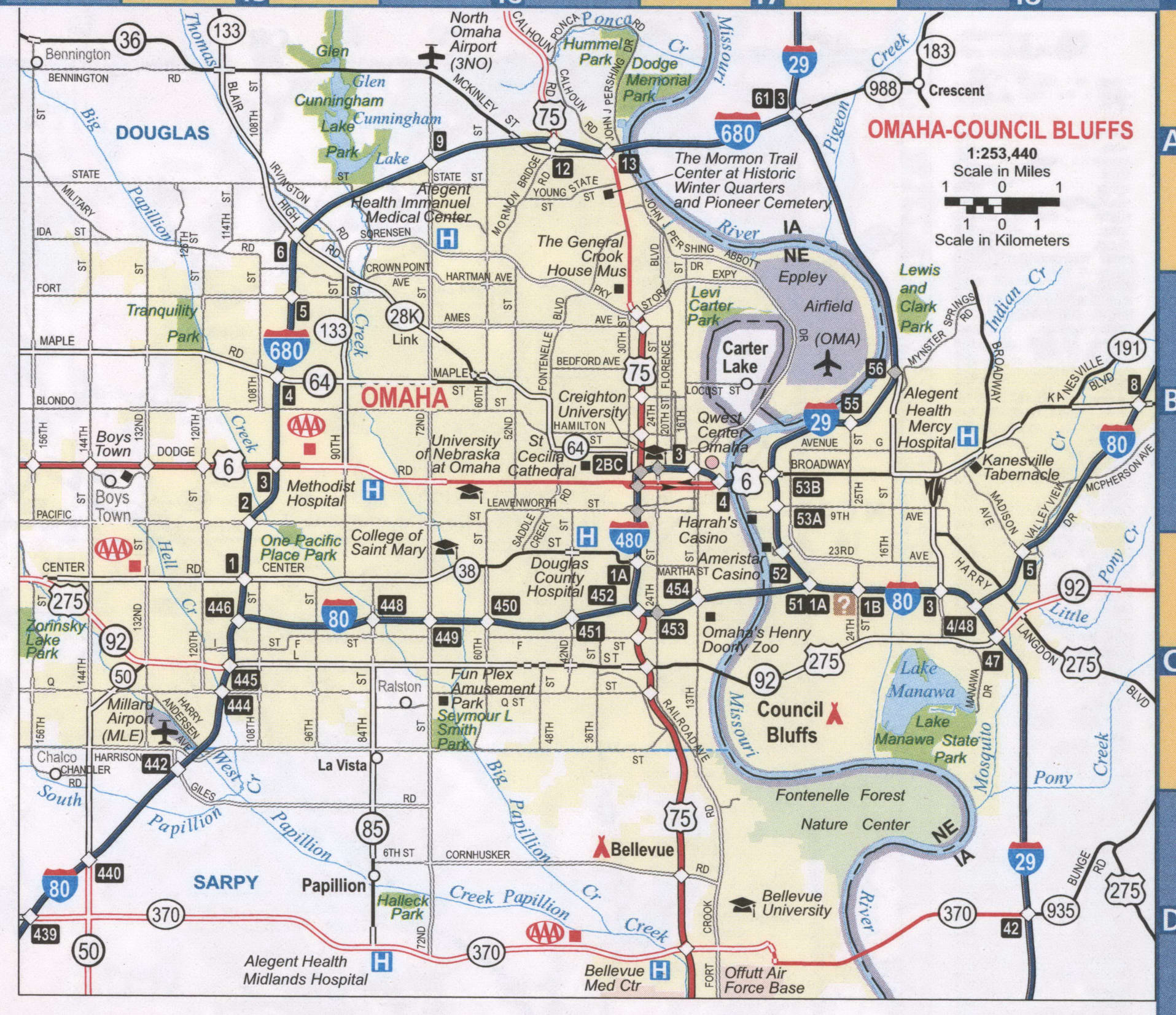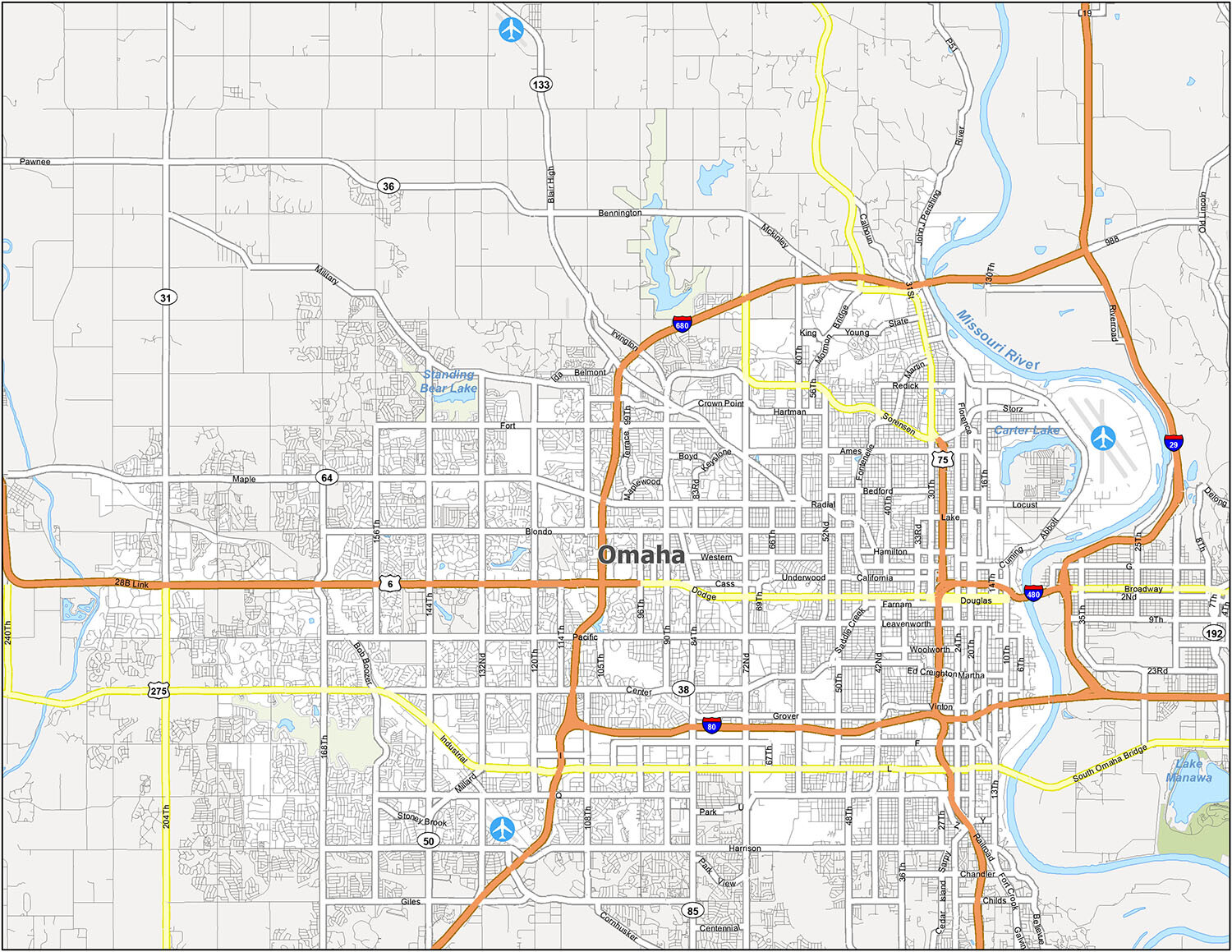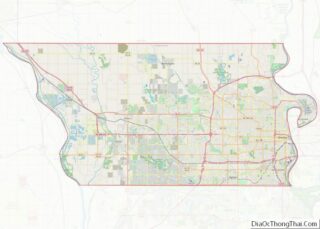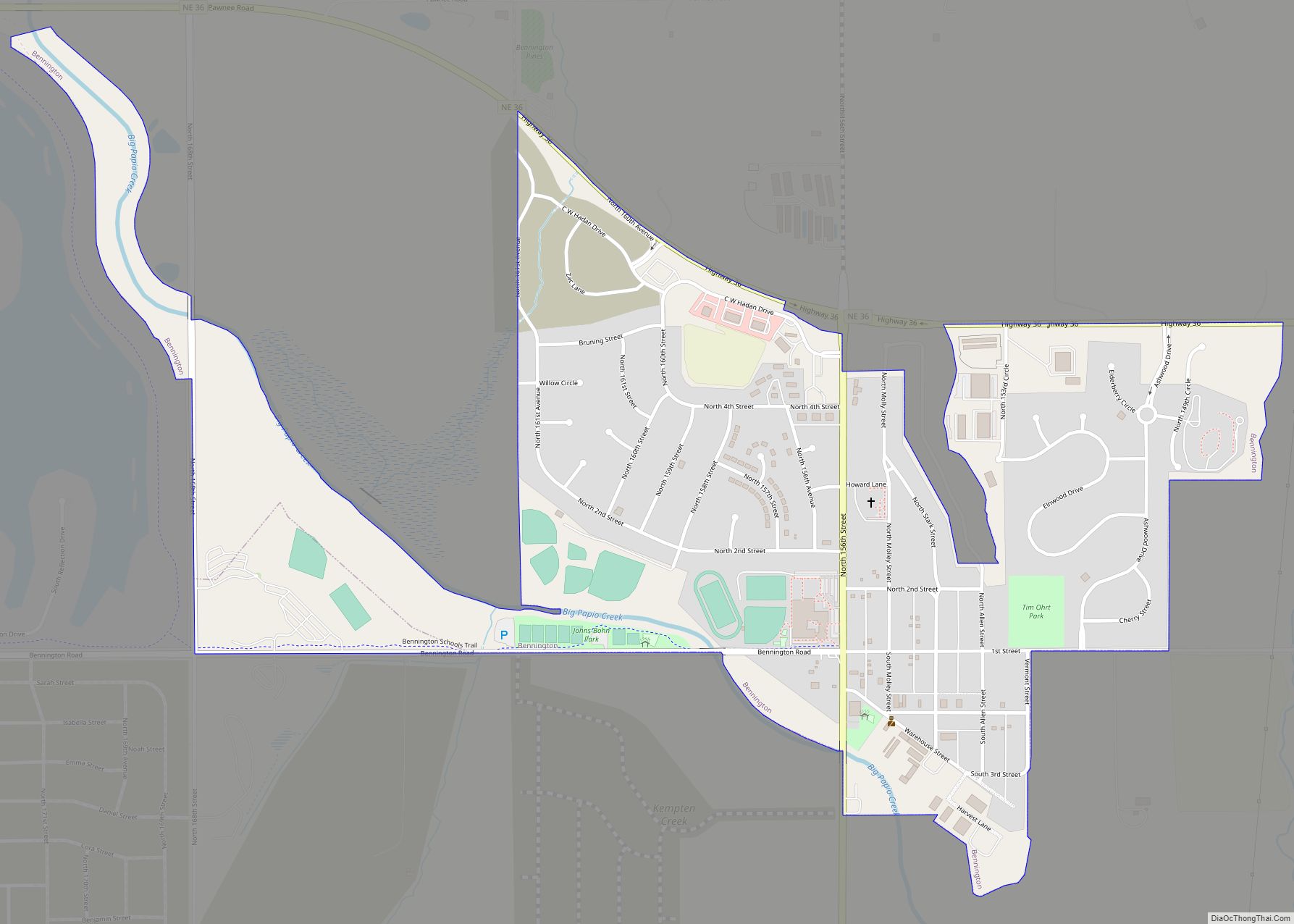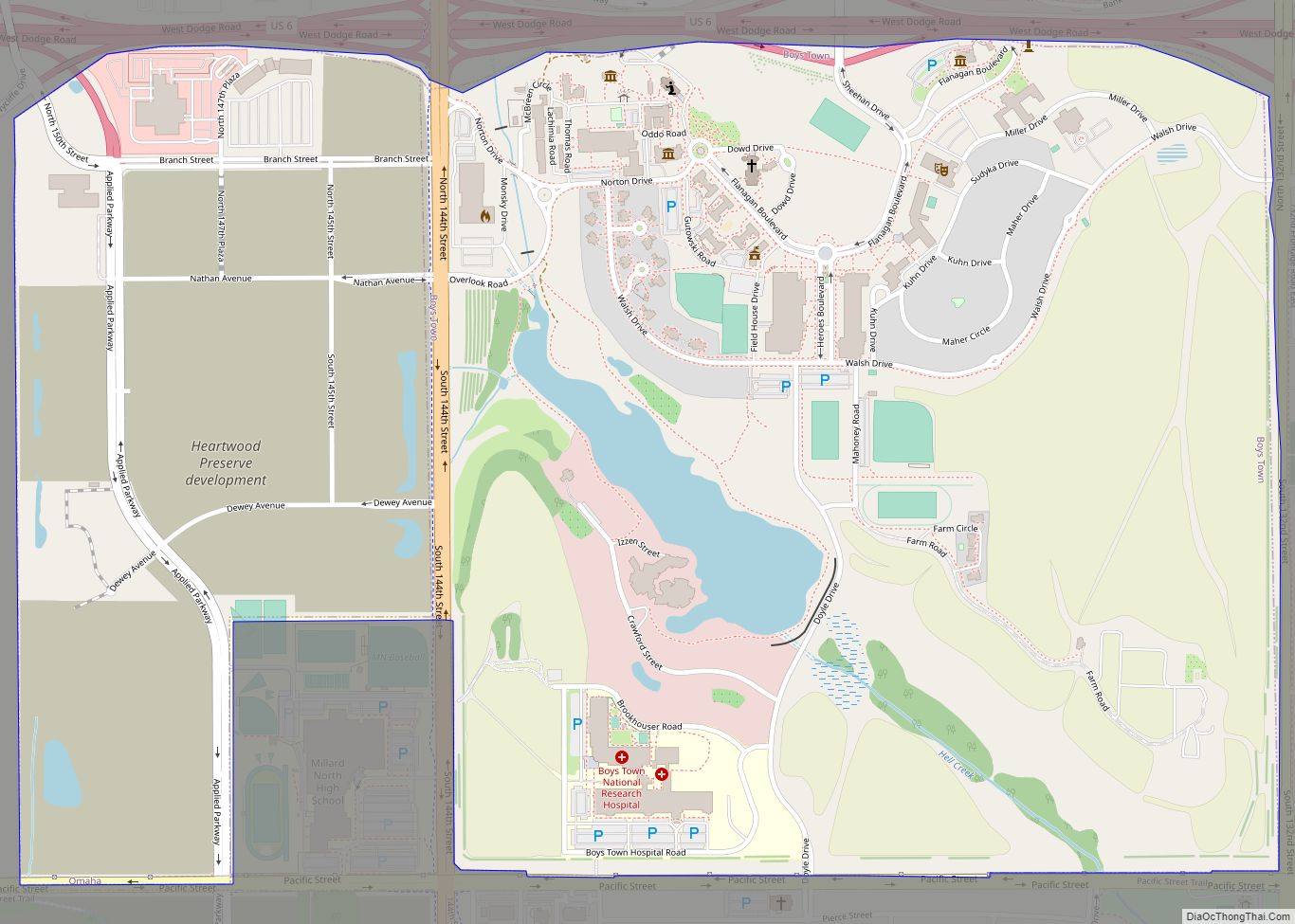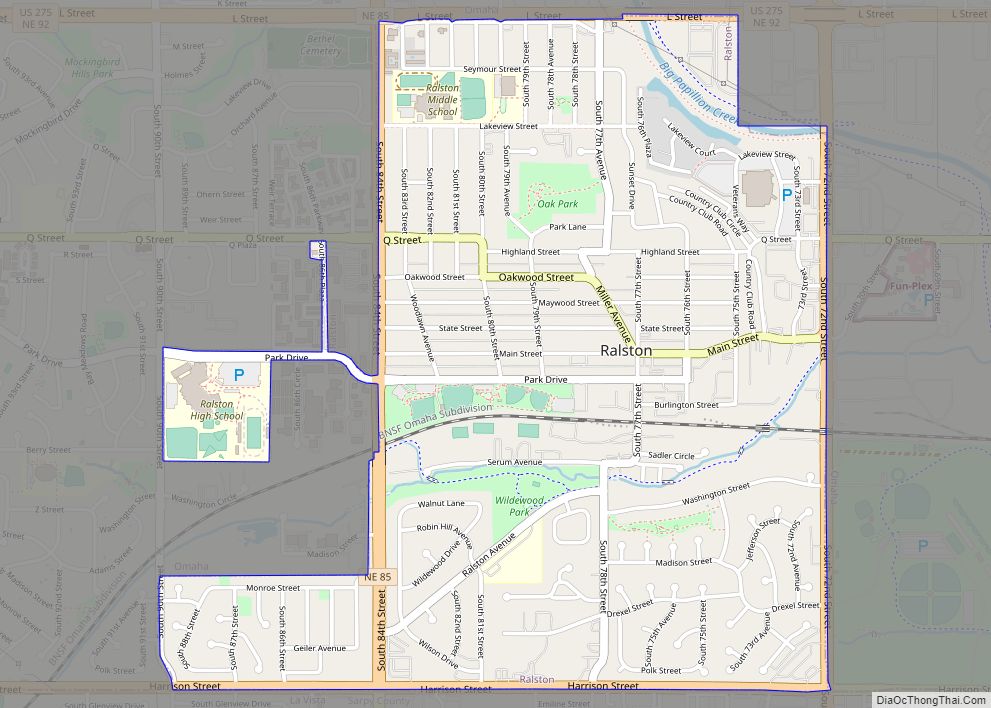Omaha (/ˈoʊməhɑː/ OH-mə-hah) is the largest city in the U.S. state of Nebraska and the county seat of Douglas County. Omaha is in the Midwestern United States on the Missouri River, about 10 mi (15 km) north of the mouth of the Platte River. The nation’s 39th-largest city, Omaha’s 2020 census population was 486,051.
Omaha is the anchor of the eight-county, bi-state Omaha-Council Bluffs metropolitan area. The Omaha Metropolitan Area is the 58th-largest in the United States, with a population of 967,604. The Omaha-Council Bluffs-Fremont, NE-IA Combined Statistical Area (CSA) totaled 1,004,771, according to 2020 estimates. Approximately 1.5 million people reside within the Greater Omaha area, within a 50 mi (80 km) radius of Downtown Omaha. It is ranked as a global city by the Globalization and World Cities Research Network, which in 2020 gave it “sufficiency” status.
Omaha’s pioneer period began in 1854, when the city was founded by speculators from neighboring Council Bluffs, Iowa. The city was founded along the Missouri River, and a crossing called Lone Tree Ferry earned the city its nickname, the “Gateway to the West”. Omaha introduced this new West to the world in 1898, when it played host to the World’s Fair, dubbed the Trans-Mississippi Exposition. During the 19th century, Omaha’s central location in the United States spurred the city to become an important national transportation hub. Throughout the rest of the 19th century, the transportation and jobbing sectors were important in the city, along with its railroads and breweries. In the 20th century, the Omaha Stockyards, once the world’s largest, and its meatpacking plants gained international prominence.
Presently, Omaha is the home to the headquarters of four Fortune 500 companies: conglomerate Berkshire Hathaway; one of the world’s largest construction companies, Kiewit Corporation; insurance and financial firm Mutual of Omaha; and the United States’ largest railroad operator, Union Pacific Corporation. Berkshire Hathaway is headed by local investor Warren Buffett, one of the wealthiest people in the world, according to a decade’s worth of Forbes rankings, some of which have ranked him as high as No. 1.
Omaha is also the home to five Fortune 1000 headquarters: Green Plains, Intrado, TD Ameritrade, Valmont Industries, and Werner Enterprises. Also headquartered in Omaha are the following: First National Bank of Omaha, the third largest privately held bank in the United States; three of the nation’s ten largest architecture/engineering firms (DLR Group, HDR, Inc., and Leo A Daly); and the Gallup Organization, of Gallup Poll fame, and its riverfront Gallup University.
Notable modern Omaha inventions include the following: the “pink hair curler” created at Omaha’s Tip-Top Products; Butter Brickle Ice Cream, and the Reuben sandwich, conceived by a chef at the then–Blackstone Hotel on 36th and Farnam Streets; cake mix, developed by Duncan Hines, then a division of Omaha’s Nebraska Consolidated Mills, the forerunner to today’s ConAgra Foods; center-pivot irrigation by the Omaha company now known as Valmont Corporation; Raisin Bran, developed by Omaha’s Skinner Macaroni Co.; the first ski lift in the U.S., in 1936, by Omaha’s Union Pacific Corp.; the Top 40 radio format, pioneered by Todd Storz, scion of Omaha’s Storz Brewing Co. and head of Storz Broadcasting, and first used in the U.S. at Omaha’s KOWH Radio; and the TV dinner, developed by Omaha’s Carl A. Swanson.
| Name: | Omaha city |
|---|---|
| LSAD Code: | 25 |
| LSAD Description: | city (suffix) |
| State: | Nebraska |
| County: | Douglas County |
| Founded: | 1854 |
| Incorporated: | 1857 |
| Elevation: | 1,060 ft (320 m) |
| Land Area: | 142.67 sq mi (369.51 km²) |
| Water Area: | 3.61 sq mi (9.35 km²) |
| Population Density: | 3,658.41/sq mi (1,315.40/km²) |
| Area code: | 402 and 531 |
| FIPS code: | 3137000 |
| GNISfeature ID: | 0835483 |
| Website: | www.cityofomaha.org |
We have the perfect map of Omaha for you to explore the city. Our map collection includes highways, roads, major landmarks, and an interactive map to explore the city. Discover Omaha’s amazing attractions, fascinating history, and diverse culture today!
Are you ready to explore Omaha? Our map collection has everything you need to start exploring the city. From highways and roads to major landmarks and an interactive map, our collection has it all. Start your journey in Omaha today!
Online Interactive Map
Click on ![]() to view map in "full screen" mode.
to view map in "full screen" mode.
The best way to explore Omaha is to see it with your own eyes. Get the most out of your stay by using this interactive map to help you find everything from local attractions to hot spots to eateries. This map includes all of the most popular attractions, places to eat, and things to do in and around Omaha. You can also visit the city’s historic sites and learn more about the city’s rich cultural heritage with this interactive map.
Omaha location map. Where is Omaha city?
Omaha Road Map
Omaha is a large city, but it doesn’t have to be confusing. If you’re looking for a way to navigate the city, a map of Omaha will help you get around the city with ease. Our map of Omaha will show you all of the interstate highways, US highways, expressways and parkways, and major roads that make up the city. Whether you’re visiting for business or pleasure, this map of Omaha will help you find the places you’re looking for. For those planning a road trip outside of the city, you can take a look at our Nebraska road map for more highway information.
Omaha, Nebraska is a thriving city located along the west side banks of the Missouri River. It is also known as “The Gateway to the West” and is known for its strong business culture. Omaha offers a lot to do, but sometimes it can be difficult to plan a trip. With this map, you can explore each neighborhood and decide what to visit, such as its lakes, rivers, and populated areas. Airports in Omaha include Blair Muni Airport (BTA), Millard Airport (MLE), and Eppley Airfield Airport (OMA). Cities in the area include Bellevue, Bennington, Carter Lake, Council Bluffs, Crescent, La Vista, Omaha, Papillion, and Ralston. Villages include Boys Town, Washington, and Waterloo. The census-designated place (CDP) of Chalco and King Lake are also located in Omaha.
10 things to do in Omaha city
Omaha is a city of surprises, boasting a stunningly rich history and a plethora of attractions. From the Henry Doorly Zoo and Aquarium to the Joslyn Art Museum, the city offers a wide range of activities and sights to explore. Whether you’re looking for a fun day out with the family or a romantic evening for two, Omaha has something for everyone. With our map, you’ll find the best things to do in Omaha, from the city’s parks and museums to its zoo and other attractions. So why not take a journey through the city and discover the hidden gems of Omaha?
Omaha city Satellite Map
Geography
According to the United States Census Bureau, the city has a total area of 130.58 sq mi (338.20 km), of which 127.09 sq mi (329.16 km) is land and 3.49 sq mi (9.04 km) is water. Situated in the Midwestern United States on the bank of the Missouri River in eastern Nebraska, much of Omaha is built in the Missouri River Valley. Other significant bodies of water in the Omaha-Council Bluffs metropolitan area include Lake Manawa, Papillion Creek, Carter Lake, Platte River and the Glenn Cunningham Lake. The city’s land has been altered considerably with substantial land grading throughout Downtown Omaha and scattered across the city. East Omaha sits on a flood plain west of the Missouri River. The area is the location of Carter Lake, an oxbow lake. The lake was once the site of East Omaha Island and Florence Lake, which dried up in the 1920s.
The Omaha-Council Bluffs metropolitan area consists of eight counties; five in Nebraska and three in Iowa. The metropolitan area now includes Harrison, Pottawattamie, and Mills Counties in Iowa and Washington, Douglas, Sarpy, Cass, and Saunders Counties in Nebraska. This area was formerly referred to only as the Omaha Metropolitan Statistical Area and consisted of only five counties: Pottawattamie in Iowa, and Washington, Douglas, Cass, and Sarpy in Nebraska. The Omaha-Council Bluffs combined statistical area comprises the Omaha-Council Bluffs metropolitan statistical area and the Fremont Micropolitan statistical area; the CSA has a population of 858,720 (2005 Census Bureau estimate). Omaha ranks as the 42nd-largest city in the United States, and is the core city of its 60th-largest metropolitan area. There are no consolidated city-counties in the area; the City of Omaha studied the possibility extensively through 2003 and concluded, “The City of Omaha and Douglas County should merge into a municipal county, work to commence immediately, and that functional consolidations begin immediately in as many departments as possible, including but not limited to parks, fleet management, facilities management, local planning, purchasing and personnel.”
Geographically, Omaha is considered as being in the “Heartland” of the United States. Important environmental impacts on the natural habitat in the area include the spread of invasive plant species, restoring prairies and bur oak savanna habitats, and managing the whitetail deer population.
Omaha is home to several hospitals, mostly along Dodge Street (US6). Being the county seat, it is also the location of the county courthouse.
Neighborhoods
Omaha is generally divided into six geographic areas: Downtown, Midtown, North Omaha, South Omaha, West Omaha, and East Omaha. West Omaha includes the Miracle Hills, Boys Town, Regency, and Gateway areas. The city has a wide range of historical and new neighborhoods and suburbs that reflect its socioeconomic diversity. Early neighborhood development happened in ethnic enclaves, including Little Italy, Little Bohemia, Little Mexico and Greek Town. According to U.S. Census data, five European ethnic enclaves existed in Omaha in 1880, expanding to nine in 1900.
Around the start of the 20th century. the City of Omaha annexed several surrounding communities, including Florence, Dundee and Benson. At the same time, the city annexed all of South Omaha, including the Dahlman and Burlington Road neighborhoods. From its first annexation in 1857 (of East Omaha) to its controversial annexation of Elkhorn in 2007, Omaha has continually had an eye towards growth.
Starting in the 1950s, development of highways and new housing led to the movement of the middle class to suburbs in West Omaha. Some of the movement was designated as white flight from racial unrest in the 1960s. Newer and poorer migrants lived in older housing close to downtown; those residents who were more established moved west into newer housing. Some suburbs are gated communities or have become edge cities. Recently, Omahans have made strides to revitalize the downtown and Midtown areas with the redevelopment of the Old Market, Turner Park, Gifford Park, and the designation of the Omaha Rail and Commerce Historic District.
Climate
Omaha, due to its latitude of 41.26˚ N and location far from moderating bodies of water or mountain ranges, displays a hot-summer humid continental climate (Köppen: Dfa). July averages 76.7 °F (24.8 °C), with average relative humidity around 70% which then leads to relatively frequent thunderstorms. Temperatures reach 90 °F (32 °C) on 29 days and 100 °F (38 °C) on 1.7 days annually. The January daily average is 23.5 °F (−4.7 °C), with lows reaching 0 °F (−18 °C) on 11 days annually. The lowest temperature recorded in the city was −32 °F (−35.6 °C) on January 5, 1884, and the highest 114 °F (45.6 °C) on July 25, 1936. Average yearly precipitation is 30.6 in (777 mm), falling mostly in the warmer months. Snow is the most common precipitation in winter, with average seasonal snowfall being 28.7 in (72.9 cm).
Based on 30-year averages obtained from NOAA’s National Climatic Data Center for the months of December, January and February, Weather Channel ranked Omaha the 5th coldest major U.S. city as of 2014.
See also
Map of Nebraska State and its subdivision:- Adams
- Antelope
- Arthur
- Banner
- Blaine
- Boone
- Box Butte
- Boyd
- Brown
- Buffalo
- Burt
- Butler
- Cass
- Cedar
- Chase
- Cherry
- Cheyenne
- Clay
- Colfax
- Cuming
- Custer
- Dakota
- Dawes
- Dawson
- Deuel
- Dixon
- Dodge
- Douglas
- Dundy
- Fillmore
- Franklin
- Frontier
- Furnas
- Gage
- Garden
- Garfield
- Gosper
- Grant
- Greeley
- Hall
- Hamilton
- Harlan
- Hayes
- Hitchcock
- Holt
- Hooker
- Howard
- Jefferson
- Johnson
- Kearney
- Keith
- Keya Paha
- Kimball
- Knox
- Lancaster
- Lincoln
- Logan
- Loup
- Madison
- McPherson
- Merrick
- Morrill
- Nance
- Nemaha
- Nuckolls
- Otoe
- Pawnee
- Perkins
- Phelps
- Pierce
- Platte
- Polk
- Red Willow
- Richardson
- Rock
- Saline
- Sarpy
- Saunders
- Scotts Bluff
- Seward
- Sheridan
- Sherman
- Sioux
- Stanton
- Thayer
- Thomas
- Thurston
- Valley
- Washington
- Wayne
- Webster
- Wheeler
- York
- Alabama
- Alaska
- Arizona
- Arkansas
- California
- Colorado
- Connecticut
- Delaware
- District of Columbia
- Florida
- Georgia
- Hawaii
- Idaho
- Illinois
- Indiana
- Iowa
- Kansas
- Kentucky
- Louisiana
- Maine
- Maryland
- Massachusetts
- Michigan
- Minnesota
- Mississippi
- Missouri
- Montana
- Nebraska
- Nevada
- New Hampshire
- New Jersey
- New Mexico
- New York
- North Carolina
- North Dakota
- Ohio
- Oklahoma
- Oregon
- Pennsylvania
- Rhode Island
- South Carolina
- South Dakota
- Tennessee
- Texas
- Utah
- Vermont
- Virginia
- Washington
- West Virginia
- Wisconsin
- Wyoming

